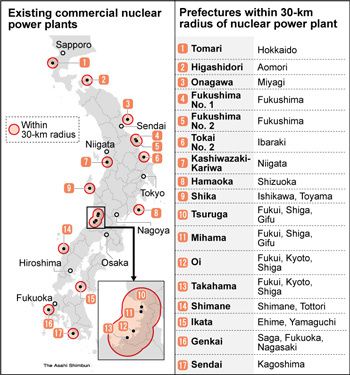
information about Fukushima published in English in Japanese media info publiée en anglais dans la presse japonaise
10 Septembre 2012
September 7, 2012
http://ajw.asahi.com/article/0311disaster/fukushima/AJ201209070078

The central government is drastically overhauling preparations for nuclear accidents, mandating sweeping new measures including requiring power plants to have more remote-controlled rescue tools and defining a broader evacuation zone for local residents.
Local authorities will be required to plan to evacuate residents over a 30-kilometer radius, expanded from the current 8-10 km, which in the case of one nuclear plant would require commandeering enough vehicles to move almost a million people. Meanwhile power-plant operators will be ordered to prepare rescue crews and logistics bases that can operate even in a radiation release.
The measures were detailed Sept. 6 in an overhauled Basic Disaster Management Plan, produced by the Central Disaster Management Council. The plan calls on plant operators, and central and local governments to rewrite their crisis manuals, and is the latest document to illustrate a fundamental rethink under way in the nation's disaster policy.
Several official inquiries and independent investigations by journalists into the March 2011 meltdowns and radiation release at the Fukushima No. 1 nuclear power plant faulted the operator, regulator and central government alike, alleging the early rescue effort suffered from insufficient equipment and the evacuation of residents from poor planning.
Until the magnitude-9.0 earthquake and tsunami, the central government and electric power companies never considered the possibility of a severe accident at a nuclear power plant because of a mistaken belief in the infallibility of existing safety measures. The new plan considers the impact of another complex disaster involving an earthquake, tsunami and nuclear accident.
The council has no power to enforce the changes, but the document will form the basis of new standards mandated by the new nuclear regulatory agency, which is due to be inaugurated in the near future.
Local governments within a 30-km radius of nuclear plants will need to compile new evacuation plans, perhaps coordinating with neighboring prefectures in order to secure temporary homes for evacuees. Local governments will be encouraged to sign support agreements to help each other in that event. The central government will be expected to help local authorities reach such agreements.
The new plan states clearly for the first time that the new nuclear regulatory agency should swiftly release radiation data, which it would acquire from the science ministry's System for Prediction of Environmental Emergency Dose Information, or SPEEDI.
That data was not immediately released after last year's Fukushima nuclear accident, giving evacuees little help in deciding where to move to.
At the same time, SPEEDI will in the future be used differently, to obtain a clearer picture of an accident as it happens.
In the event of an accident, all residents within 5 km would immediately evacuate, without waiting for data from SPEEDI.
Other changes in the basic plan arose from failure by the prime minister's office and the Nuclear and Industrial Safety Agency to share information as the Fukushima disaster unfolded.
Under the new plan, once an accident occurs, the chairman of the nuclear regulatory agency and other officials will immediately go to the prime minister's office to form a crisis secretariat that then serves as a clearinghouse for information.
Electric power companies will be asked to construct an emergency response center at each nuclear plant, as well as a support base in a location where on-site workers can receive deliveries of equipment and materials from outside.
The utilities will also be asked to form an accident response center at company headquarters and give free access to nuclear regulatory agency staff, who would then coordinate communications with other agencies and monitor the company's activity, such as its compliance with regulatory agency orders.
Plant operators will also be asked to install heavy machinery that can be operated by remote control. They will also need to form nuclear-accident rescue squads that can function regardless of the high radiation levels that make such work difficult and dangerous.
The companies will also have to conduct training exercises to deal with possible major accidents and will be required to report on the exercise results. If those results show failings, the nuclear regulatory agency will be able to order improvements.
Meanwhile, the utilities' share of the burden will be matched, if not exceeded, by what local governments will need to do.
For example, the Ibaraki prefectural government will need to prepare to evacuate close to 1 million residents in the event of an accident at the Tokai No. 2 nuclear plant, operated by Japan Atomic Power Co.
The new 30-km radius around that plant will include 14 municipalities, with a total population of about 940,000. One of the cities is Mito, the prefectural capital, which lies about 20 km from the plant. In a severe accident at the Tokai No. 2 plant, the prefectural government office itself could be rendered unusable.
Prefectural government officials plan to use cars and buses to evacuate residents. But even if they could round up all 7,000 or so buses in the prefecture, those vehicles would be able to transport only 240,000 people at a time.
A prefectural government official in charge of safety measures for nuclear accidents said more information is needed. The central government, the official said, should issue technical guidelines on what kind of accident requires which evacuation.
Other prefectures will need to depend upon the goodwill of neighboring prefectures to help house their evacuees.
Within a 30-km radius of the Shimane nuclear plant lie four cities, with a total population of about 396,000. However, across Shimane Prefecture, municipalities can house only 160,000 evacuees at most.
For that reason, the Shimane prefectural government asked four nearby prefectures to accept evacuees in the event of an accident. It obtained consent from Tottori, Hiroshima and Okayama prefectural governments, and in February came up with a list of 71 municipalities that could host evacuees.
THE ASAHI SHIMBUN